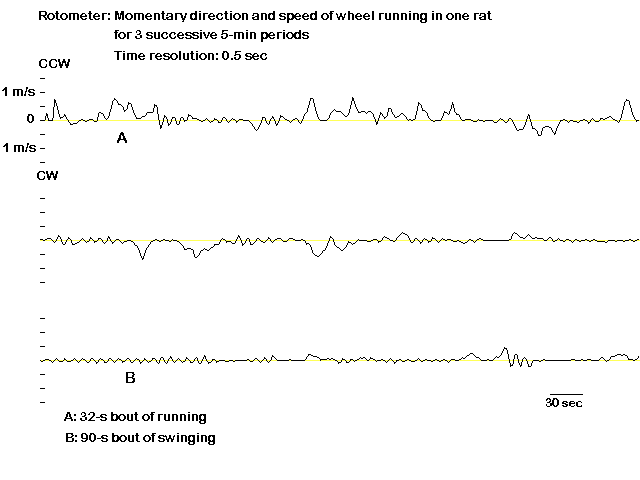
An inexpensive method to automate the recording of direction and speed of individual bouts of wheel running in rats
I.H. Iversen
Department of Psychology, University of North Florida, Jacksonville, FL, U.S.A.
The speed and direction of wheel rotation can be monitored automatically by attaching a roller from a computer mouse directly to the axle of a running wheel. The modification of the computer mouse is very simple and does not require any modification of electronic components. Any programming language with mouse routines can be used to detect and analyze wheel rotation. Rotation of the wheel simply moves the cursor in the vertical or horizontal plane depending on which roller is attached to the wheel. Rotation was measured with QuickBasic 4.5 using the mouse routines from QuickPro (Crescent Software, Inc.) or Visual Basic 1.0 (DOS version), which incorporates mouse routines. Every 0.5 s the program assesses how far the wheel has turned within the past 0.5 s; the cursor position is reset after each mouse reading. For the mouse used, one full wheel revolution corresponds to a cursor displacement of 54 pixels. The measurement generates very simple data files with a string of numbers that represent speed and direction of running for each 0.5 s period. Positive values represent counter-clockwise (CCW) rotation and negative numbers clockwise (CW) rotation. Thus, 20 entries to a data file may read: 0, 0, 10, 15, 20, 18, 17, 9, -1, 0,0, -6, -9, -16, -32, -14, -4, 5, 0,0. The wheel is at rest, followed by positive acceleration (CCW) up to a peak speed of 20, followed by deceleration, followed by CW rotation with a peak speed of 32. The figure illustrates the flow of wheel rotation for one Long Evans female rat during the first 15 min of a 1-hr session of free access to running. The letter A illustrates a bout of running lasting about 30 s with a peak speed near 1 meter/s. The rat runs in both directions and also "swings" back and forth in the wheel, as indicated at B. Different topographies of rotation such as a "bout" of running, a bout of swinging, a bout of "walking" can be defined precisely either online or offline. The methodology has been used successfully to monitor and analyze free running, running as an operant response, and running as a reinforcing response. The poster will show how to set up the equipment and some excerpts from the programs showing how to detect speed and direction. Data from actual experiments will illustrate the use of the method, which is tentatively called a Rotometer.


Poster presented at Measuring Behavior '98, 2nd International Conference on Methods and Techniques in Behavioral Research, 18-21 August 1998, Groningen, The Netherlands